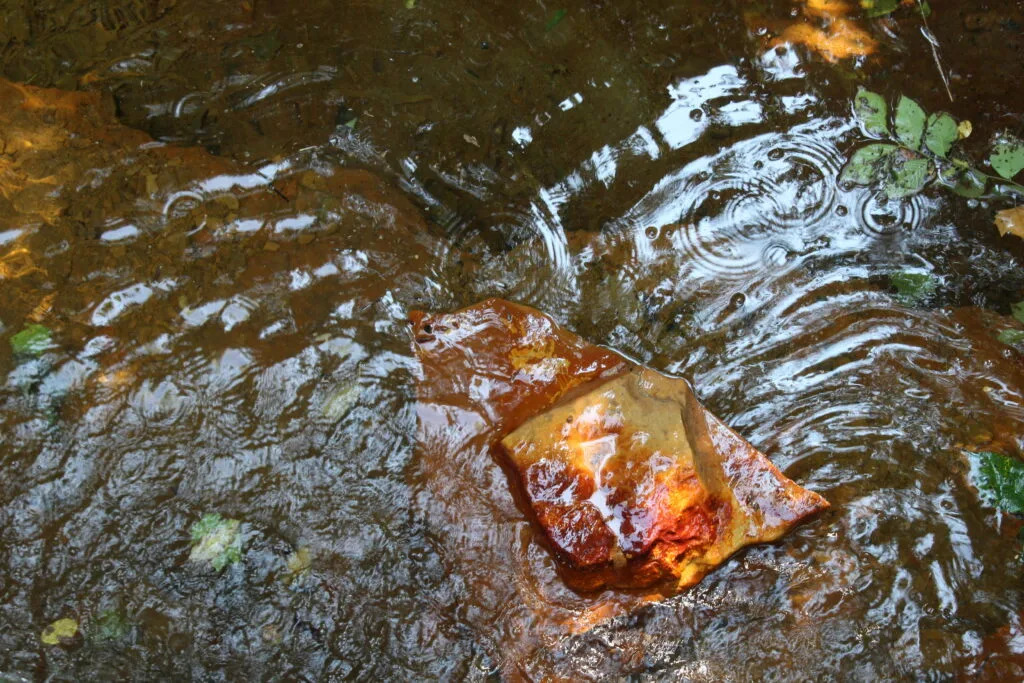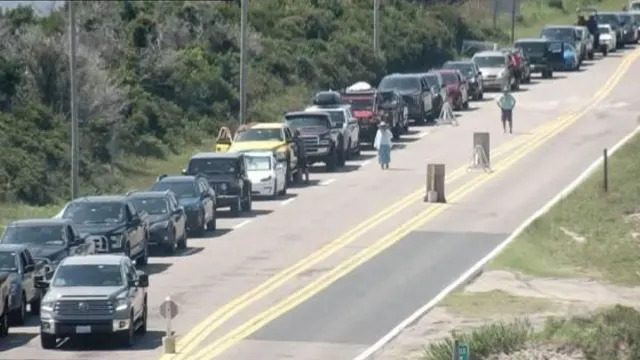
Rocks stained by acid mine drainage in Monday Creek, photographed on Aug. 12, 2025. (Photo by Megan Henry, Ohio Capital Journal.)
Stretches of rust orange, acidic water flow through hilly southeastern Ohio, but Rural Action has helped bring aquatic life back to the streams.
Monday Creek Watershed flows 27 miles through parts of Athens, Hocking, and Perry counties and drains into the Hocking River south of Nelsonville, but it is heavily polluted by acid mine drainage, which is contaminated water formed when iron is exposed to the air and water. The acid mine drainage is caused by pre-regulated mining and makes it nearly impossible for aquatic life to survive in that environment.
SUBSCRIBE: GET THE MORNING HEADLINES DELIVERED TO YOUR INBOX
“Water is extremely important to communities and sustainability,” said Rural Action Watershed Program Director Nate Schlater. “We all need water to live.”
The United States Department of Agriculture ranked Monday Creek as the third most severely acid drainage polluted stream in Ohio in 1985 and Rural Action has been doing watershed restoration work since 1994.
“These streams, which were nearly completely devoid of life, have seen vast improvements in chemical and biological water quality because of the work of this coalition,” said Matt Ledford, a Rural Action water quality specialist.
Clean water is necessary for a healthy ecosystem, he said.
“Human health and development – everything from drinking water, groundwater recharge, flood management and much more rely on a healthy, functioning ecosystem,” Ledford said.
Monday Creek was once considered a dead stream, meaning it lacked aquatic life.
“That is typically the result of pre-regulation abandoned coal mine impacts and the acidic water and the metals associated with those impacts and discharges,” Schlater said.
Today, 37 fish species have either returned to Monday Creek or are living in Monday Creek, Schlater said.
“That is the result of treatment and reclamation of pre-regulation coal mining issues,” he said. “… Some of those had lived there early on, but most of those had not been there for the past 100 years. … It’s literally life and death for biology and aquatic life in these streams.”
But there is still work to be done as Schlater recently found only two species of fish in a tributary to Monday Creek.
“That’s essentially as poor as it can get,” he said.
Rural Action does weekly maintenance on Monday Creek and uses limestone dosers filled with pulverized limestone to help neutralize the acidity.
“It’s ricotta lasagna,” Ledford said on a recent weekly maintenance trip upon seeing the limestone mix with the acid mine drainage in the water.
The weekly maintenance involves several stops at various points along Monday Creek to check the water’s pH levels. Seven is a neutral pH level.
“The lime is going to drive the pH level up, drive it up from like a two or three to like a 10,” he said. “… So then you’re gonna have highly alkaline water from here … hopefully that’ll bring the pH down … once it mixes into (the acid mine drainage), it gets diluted, and then we’re back down around seven.”
A lot of the Rural Action’s watershed program focuses on abandoned mine land restoration, Schlater said.
“We’ve seen around 74 stream miles improved as a result of that work in the areas that we’re focusing on,” Schlater said.
The watershed program also focuses on non-point source water quality impairments, which is a pollution source that is not coming from a regulated pipe.
“Non-point source would be water that runs onto the field and it brings a bunch of nutrients and sediment out of the field with it, into the creek, and that causes some pollution into the creek,” Schlater said. “There’s a lot of stormwater inputs from upstream that are causing sediment and nutrients and stuff to enter the streamways, but it’s not coming from a regulated pipe of any type.”
Coal mining in Ohio
Coal mining in Ohio started around 1800 and was unregulated until the Strip Coal Mining Act took effect in 1947, according to the Ohio Department of Natural Resources. More than 3.7 billions of coal have been mined in Ohio since 1800, according to ODNR.
Belmont County has produced the most coal in Ohio, followed by Harrison and Jefferson counties, according to ODNR. Perry, Athens, Tuscarawas, Guernsey, Meigs, Muskingum and Noble counties are also considered historically high coal producing counties.
There were 1,155 underground mines operating in Ohio in 1898, compared to seven in 2003, according to ODNR.
“There’s so many square miles of underground mines here,” Ledford said. “They mined everything here. Before coal, it was clay (and) timber. Coal mining was obviously the biggest money maker. It powered the Industrial Revolution.”
Regulated mining still takes place in Ohio today. There were 26 surface mines in Athens, Belmont, Columbiana, Guernsey, Harrison, Jackson, Noble, Tuscarawas and Vinton counties in 2023, according to ODNR. There were two underground mines in Harrison County in 2023.
“Any mining of any sort of anything is going to cause those effects,” Ledford said. “These things are regulated now and effects aren’t just completely devastating as they were and continue to be, but they’re still bad.”
Rural Action does weekly maintenance on Monday Creek and uses lime to neutralize the acidity in acid mine drainage, photographed on Aug. 12, 2025. (Photo by Megan Henry, Ohio Capital Journal.)
Rural Action does weekly maintenance on Monday Creek and uses lime to neutralize the acidity in acid mine drainage, photographed on Aug. 12, 2025. (Photo by Megan Henry, Ohio Capital Journal.)
Rural Action does weekly maintenance on Monday Creek and uses lime to neutralize the acidity in acid mine drainage, photographed on Aug. 12, 2025. (Photo by Megan Henry, Ohio Capital Journal.)
Monday Creek in southeast Ohio is heavily polluted by acid mine drainage, photographed on Aug. 12, 2025. (Photo by Megan Henry, Ohio Capital Journal.)
Sunday Creek in southeast Ohio is heavily polluted by acid mine drainage, photographed on Aug. 12, 2025. (Photo by Megan Henry, Ohio Capital Journal.)
A former mine near Sunday Creek, which is heavily polluted by acid mine drainage, photographed on Aug. 12, 2025. (Photo by Megan Henry, Ohio Capital Journal.)
Sunday Creek in southeast Ohio is heavily polluted by acid mine drainage, photographed on Aug. 12, 2025. (Photo by Megan Henry, Ohio Capital Journal.)
Sunday Creek in southeast Ohio is heavily polluted by acid mine drainage, photographed on Aug. 12, 2025. (Photo by Megan Henry, Ohio Capital Journal.)
Monday Creek in southeast Ohio is heavily polluted by acid mine drainage, photographed on Aug. 12, 2025. (Photo by Megan Henry, Ohio Capital Journal.)
Rocks stained by acid mine drainage in Monday Creek, photographed on Aug. 12, 2025. (Photo by Megan Henry, Ohio Capital Journal.)
Rural Action does weekly maintenance on Monday Creek and uses lime to neutralize the acidity in acid mine drainage, photographed on Aug. 12, 2025. (Photo by Megan Henry, Ohio Capital Journal.)
Monday Creek in southeast Ohio is heavily polluted by acid mine drainage, photographed on Aug. 12, 2025. (Photo by Megan Henry, Ohio Capital Journal.)
Monday Creek in southeast Ohio is heavily polluted by acid mine drainage, photographed on Aug. 12, 2025. (Photo by Megan Henry, Ohio Capital Journal.)
Bee Huelsman (left) and Anisa Corp, AmeriCorps members, do weekly maintenance on Monday Creek, photographed on Aug. 12, 2025. (Photo by Megan Henry, Ohio Capital Journal).
Monday Creek in southeast Ohio is heavily polluted by acid mine drainage, photographed on Aug. 12, 2025. (Photo by Megan Henry, Ohio Capital Journal.)
Monday Creek in southeast Ohio is heavily polluted by acid mine drainage, photographed on Aug. 12, 2025. (Photo by Megan Henry, Ohio Capital Journal.)
AmeriCorps members Bella Kirchner (left), Bee Huelsman (middle) and Anisa Corp (right) do weekly maintenance on Monday Creek, photographed on Aug 12. 2025. (Photo by Megan Henry, Ohio Capital Journal.)
Follow OCJ Reporter Megan Henry on Bluesky.








Comments